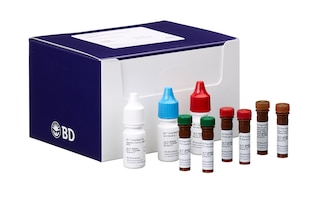Old Browser
This page has been recently translated and is available in French now.
Looks like you're visiting us from {countryName}.
Would you like to stay on the current country site or be switched to your country?




Flow cytometric analysis of FITC Rat Anti-SSEA-3 on H9 cells. H9 human embryonic stem (ES) cells (WiCell, Madison, WI) were stained with either FITC Rat Anti-SSEA-3 (solid line) or FITC rat IgM (R4-22) isotype control (Cat. No. 553942, dashed line), incubated in the dark for 20 minutes at room temperature and analyzed by flow cytometry. Flow cytometry was performed on a BD FACSCalibur™ System.


BD Pharmingen™ FITC Rat anti-SSEA-3

Regulatory Status Legend
Any use of products other than the permitted use without the express written authorization of Becton, Dickinson and Company is strictly prohibited.
Preparation And Storage
Product Notices
- This reagent has been pre-diluted for use at the recommended Volume per Test. We typically use 1 × 10^6 cells in a 100-µl experimental sample (a test).
- An isotype control should be used at the same concentration as the antibody of interest.
- Caution: Sodium azide yields highly toxic hydrazoic acid under acidic conditions. Dilute azide compounds in running water before discarding to avoid accumulation of potentially explosive deposits in plumbing.
- Source of all serum proteins is from USDA inspected abattoirs located in the United States.
- For fluorochrome spectra and suitable instrument settings, please refer to our Multicolor Flow Cytometry web page at www.bdbiosciences.com/colors.
- Please refer to www.bdbiosciences.com/us/s/resources for technical protocols.
Companion Products



.png?imwidth=320)


The MC-631 monoclonal antibody reacts with Stage-Specific Embryonic Antigen-3 (SSEA-3), a carbohydrate epitope on the major ganglioside, but not the neutral glycolipid, of mouse embryos and human teratocarcinoma cells. As its name implies, the expression of SSEA-3 is stage-specific and can be used to characterize embryonic cells and monitor their differentiation. However, its expression pattern differs between human and mouse. In the human, SSEA-3 is found on teratocarcinoma (embryonal carcinoma or EC), embryonic inner cell mass (ICM), embryonic stem (ES) cells, and erythrocytes. As human stem cells undergo differentiation, SSEA-3 expression diminishes. In the mouse, SSEA-3 is found on oocytes, ova, zygotes, early cleavage-stage embryos, early blastocysts, ICM, primitive endoderm, and adult kidneys, but not on EC or ES cells.

Development References (6)
-
Draper JS, Pigott C, Thomson JA, Andrews PW. Surface antigens of human embryonic stem cells: changes upon differentiation in culture. J Anat. 2002; 200:249-258. (Clone-specific: Flow cytometry). View Reference
-
Henderson JK, Draper JS, Baillie HS, et al. Preimplantation human embryos and embryonic stem cells show comparable expression of stage-specific embryonic antigens. Stem Cells. 2002; 20:329-337. (Clone-specific: Flow cytometry, Immunocytochemistry (cytospins)). View Reference
-
Kannagi R, Cochran NA, Ishigami F, et al. Stage-specific embryonic antigens (SSEA-3 and -4) are epitopes of a unique globo-series ganglioside isolated from human teratocarcinoma cells. EMBO J. 1983; 2(12):2355-2361. (Clone-specific: Immunofluorescence). View Reference
-
Shevinsky LH, Knowles BB, Damjanov I, Solter D. Monoclonal antibody to murine embryos defines a stage-specific embryonic antigen expressed on mouse embryos and human teratocarcinoma cells. Cell. 1982; 30:697-705. (Immunogen: Cytotoxicity, Immunofluorescence, Immunoprecipitation, Radioimmunoassay). View Reference
-
Son YS, Park JH, Kang YK, et al. Heat shock 70-kDa protein 8 isoform 1 is expressed on the surface of human embryonic stem cells and downregulated upon differentiation. Stem Cells. 2005; 23:1502-1513. (Clone-specific: Flow cytometry, Immunocytochemistry (cytospins)). View Reference
-
Thomson JA, Itskovitz-Eldor J, Shapiro SS, et al. Embryonic stem cell lines derived from human blastocysts. Science. 1998; 282:1145-1147. (Clone-specific: Immunocytochemistry (cytospins)). View Reference
Please refer to Support Documents for Quality Certificates
Global - Refer to manufacturer's instructions for use and related User Manuals and Technical data sheets before using this products as described
Comparisons, where applicable, are made against older BD Technology, manual methods or are general performance claims. Comparisons are not made against non-BD technologies, unless otherwise noted.
For Research Use Only. Not for use in diagnostic or therapeutic procedures.
Report a Site Issue
This form is intended to help us improve our website experience. For other support, please visit our Contact Us page.